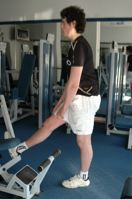Good hamstring flexibility prevents adverse pressure on the pelvis and knees. Tight hamstrings pull the pelvis downwards, flattening the lumbar curve, and so can contribute to back problems. They also hold the knees bent, and can play a part in problems in the kneecap joints and the main (tibiofemoral) knee joints.
 Position: Stand with the leg to be stretched on a low support. Keep your back straight, head up.
Position: Stand with the leg to be stretched on a low support. Keep your back straight, head up.
To stretch: Lean forwards a little way, keeping your foot up, knee and back straight, head up. When you feel a gentle stretching sensation on the back of the thigh, hold the position without moving for a count of 6, then relax completely.
Repetitions and frequency: 3-10 times, 1-2 times a day
Note: Avoid pain. Do not over-stretch, or stretch further from the stretched position. Do not drop your head or curve your back. Do not force the movement to try to touch your toes.
After injury: This exercise is essential following hamstring injuries of any kind. It can be done from the earliest phases of recovery, strictly within pain limits and without strain. It is also needed after knee and back problems, but must always be done with care, and in the later stages of recovery. It is relevant after injuries to the lower leg which have caused a limp. As the hamstrings compensate for calf muscle weakness, it should also be done following any injury to the calf muscles and Achilles tendon.


